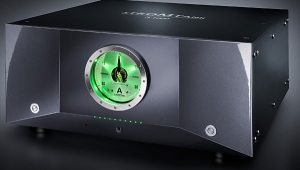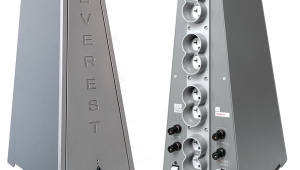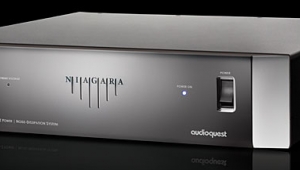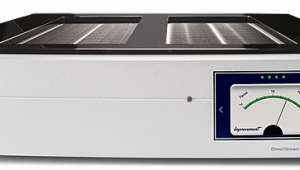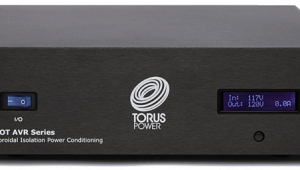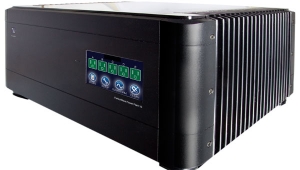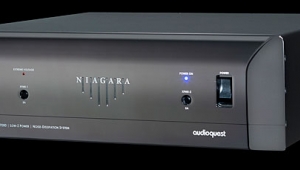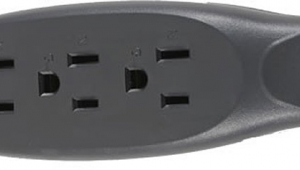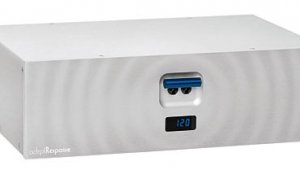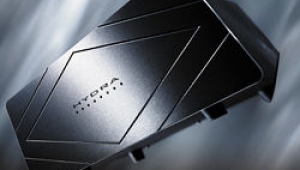| Columns Retired Columns & Blogs |
PS Audio Ultimate Outlet AC conditioner Page 3
Since the P300 doesn't have enough output to run most amplifiers comfortably, my normal practice is to use it only for the preamp and source components, letting the amplifiers make do with AC from the wall socket. This is the way I initially set up the 47 Laboratory Gaincard (also reviewed in this issue) and the Quicksilver Horn Mono amplifiers (review to come). Running the amplifiers so that they got their power from a UO (I used the 20-amp IEC version) resulted in improvements similar to what I had found when used at the front end (improved clarity, better dynamics), but the effects were smaller in magnitude. I also tried the UO with the Bryston 9B-THX (120Wx5) in my home-theater system, again with a beneficial effect.
Overkill?
The Power Plant takes raw AC from the wall, converts it to DC, then converts it back to AC, precisely regulating the output voltage and using a DSP-based signal generator to produce a pure 60Hz AC sinewave or the alternative MultiWave combination of waveforms. The Power Plant's output has demonstrably lower noise and distortion than raw AC, and might be expected to be impervious to all but the most marked variations in the quality of AC supply. To use a UO at the input of the Power Plant might seem redundant, or to amount to overkill. Nevertheless, PS Audio says that, used in this configuration, the UO can produce some useful "pre-cleaning" of the AC, with further sonic benefits.
Well, I tried this combination, and I have to agree with PS Audio's recommendation. The difference was not night-and-day, but the sound became a bit more open and more dynamic, and there was some reduction of upper-frequency grain. The results were better with the High Current UO than with the Standard.
I also tried plugging the UO (Standard or High Current) into one of the P300's outputs, then plugging the digital source components into the UO. This is the recommended setup for preventing the digital components from dumping noise back into the P300. I compared the sound of this combination to the sound with the digital components plugged directly into the P300. Result: no difference that I could consistently identify. This is not to say that there would be no audible effect with other digital components or in other systems, but in the hierarchy of PLC-related improvements, I would put on the lowest level the addition of a UO after the P300 just for digital components.
Buying Guide
For those unfortunate souls whose audio systems are still powered by AC as it comes out of the wall socket, I recommend PS Audio's Standard Ultimate Outlet as the least expensive product that demonstrates the audible benefits of PSA's approach to power-line conditioning.
However, if you can afford $299 for the Standard, I strongly urge that you spend the extra $100 for the High Current UO (15- or 20-amp IEC version, depending on what type of power cord you use). With the High Current UO, you get the higher-quality Power Port socket (which would cost $49.50 if you were to buy it separately) and sound quality that's significantly better than with the Standard UO. Although the P300 Power Plant offers even better sonic performance, it does so at a much higher initial cost, and has the disadvantages of an amplifier compared to a passive component like the UO: heat, ongoing cost of power consumption, and having to find the space for yet another bulky component in your listening room.
One practical limitation of the UO is that it has only two AC sockets, which means that you'll probably have to spring for a high-quality power bar like PS Audio's Juice Bar—another $199. (You don't want to compromise here by getting a $9.95 Home Depot special.) The High Current UO is recommended for all amplifiers.
For those who already have a P300, adding a High Current UO upstream would represent an improvement in sound quality that's more than commensurate with the price. You might also want to try another UO at the output of the P300 just for digital components, but my experience suggests that this is not going to make as much of a difference as a UO at the input side. (PS Audio's 30-day home trial policy makes checking this out easy.)
The product I'd like to see from PS Audio is a Power Plant with a built-in High Current UO at the input. This would mean less clutter, save the cost of one high-end power cord, and, in all likelihood, the sound would be as good as or better than with a separate UO. I won't be surprised if this is incorporated into the next generation of Power Plant products. In any case, the Ultimate Outlet gives PS Audio another winner in the power-line-conditioning sweepstakes.
- Log in or register to post comments
